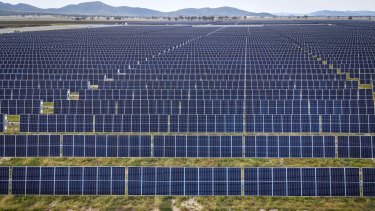Ambitious renewable energy investment drives from state governments mean Australia can boost its 2030 emissions reduction target ahead of the United Nations climate summit in Glasgow next month without the federal government making any new commitments.
Analysts said state investments and policies to develop renewable energy zones and tap private investment into wind and solar farms would be enough to beef up Australia’s current emissions target by almost 10 percentage points.
Swapping coal-fired power with clean solar and wind would remove enough carbon pollution over the next decade to cut Australia’s emissions 35 per cent by 2030. Australia has committed to cutting emissions by at least 26 per cent by 2030, based on 2005 levels, but is under international pressure to lift that target.

State governments have set ambitious emissions reduction goals based on policies that encourage private investment in renewable energy, like at this solar farm in Gunnedah, NSW, to replace coal fired power. Credit:Bloomberg
The federal Energy Department’s official projections assume rooftop and large-scale renewable energy farms are expected to grow from 27 per cent of the National Energy Market to 55 per cent by 2030.
Fresh climate targets and a low emissions technology road map are set to be released by the federal government next week. It could choose to announce a binding upgrade to its 2030 target, or it may release projections that forecast Australia will achieve deeper emissions cuts without locking the government into an agreement.
Victoria’s Energy, Environment and Climate Change Minister Lily D’Ambrosio urged the federal government to mirror states’ commitments.
“The Morrison government should follow our lead and set interim targets to halve emissions by 2030 so that we can give our planet a fighting chance by getting emissions well below 2 degrees and as close as possible to 1.5 degrees,” Ms D’Ambrosio said.
Grattan Institute energy policy director Tony Wood said the credibility of the federal and state emissions commitments would depend on new policies that show how the cuts will be achieved. But their credibility will hinge on new policies that outline how the government will work with industry to achieve their targets.
“It’s most likely the electricity sector will be close to 50 per cent by 2030 and that means we can expect to see emissions reductions between 30 and 35 per cent by 2030,” Mr Wood said.
Electricity generation is the one high polluting industry that state governments have significant control over.
Prime Minister Scott Morrison wants to reach net zero emissions “as quickly as possible” and “preferably” by 2050, but the federal government has not committed to a deadline. All states and territories have set a net zero by 2050 goal, and NSW and Victoria are aiming for a cut of 50 per cent by 2030.
Climate Council senior researcher Tim Baxter said the state and territory governments had “ripped the rug out from under the federal government’s feet”.
“Just meeting state and territory targets – without any effort from the federal government at all – would take us to something like 34 per cent below 2005 levels in 2030,” Mr Baxter said.
Mr Baxter said government support for the development of gas fields like the Beetaloo in the Northern Territory and Galilee in Queensland could undo the emissions goals set by the states.
“Each of these basins is on its own terms a colossal carbon bomb. Should all five proceed it will be game over for Australia on ever being taken seriously on climate change again.”
Ms D’Ambrosio said Victoria had invested $1.6 billion in renewable energy to tap jobs growth.
“Strong and certain targets create a pipeline of projects and jobs – this is why 30 per cent of Australia’s renewable energy jobs are in Victoria, more than any other state,” she said.
Chief executive of the ClimateWorks think tank, Anna Skarbek, told the Committee for the Economic Development of Australia on Tuesday that Australia needed to cut carbon emissions by at least 50 per cent by 2030 to act consistently with global action needed to limit global warming to two degrees.
She said state and federal policies were “fragmented” and consistent national plans were needed to coordinate investments at polluting industries that will be disrupted by the push to decarbonise – like fossil fuels and mining — and help workers and communities transition to a low emissions economy.
“There are about a dozen regions around Australia that are ripe for this that have the industrial facilities in place, the workforces, the access to renewable energy, and the opportunity to harness this,” Ms Skarbek said.
Most Viewed in Politics
https://news.google.com/__i/rss/rd/articles/CBMifmh0dHBzOi8vd3d3LnNtaC5jb20uYXUvcG9saXRpY3MvZmVkZXJhbC9zdGF0ZXMtcGF2aW5nLXdheS1mb3ItcHJpbWUtbWluaXN0ZXItdG8tYm9vc3QtMjAzMC1jbGltYXRlLXRhcmdldC0yMDIxMTAxMi1wNTh6YmQuaHRtbNIBAA?oc=5
2021-10-12 20:45:56Z
52781934243507
Bagikan Berita Ini














0 Response to "States paving way for Prime Minister to boost 2030 climate target - Sydney Morning Herald"
Post a Comment